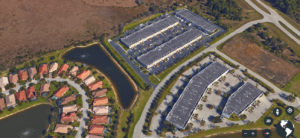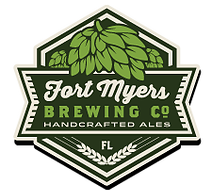| With numerous preserves, countless lakes and
vast green-space, Gateway enjoys an amazing array of wildlife. Listed are some of the more exotic and prevalent, in no
particular order. |
| |
| MAMMALS |
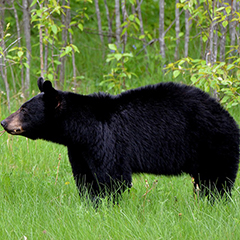 |
|
American Black bear (Ursus
americanus) - Not usual inhabitants of Gateway, but black bears do pass through
from time-to-time, if only to frighten the occasional golfer or newcomer.
Bears should never be fed. Though there haven't been any incidents with
humans, it is always best to leave them be and/or call wildlife
officials if necessary. |
|
|
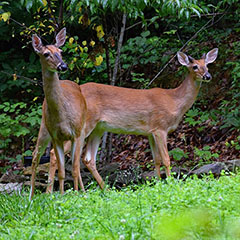 |
|
White-tailed deer (Odocoileus
virginianus) - development in surrounding communities have reduced
their habitat, but they're still with us and still bearing
fawns. |
|
|
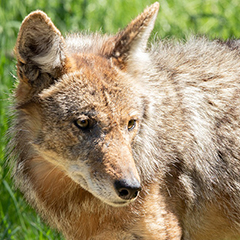
|
|
Coyote (Canis latrans) -
In previous years, Coyotes were rarely seen south of the Caloosahatchee.
These days there are frequent sightings, mostly at night when they
can often be heard howling. |
| |

|
|
Wild boar (Sus scrofa) -
Another species - this one considered invasive - that wasn't prevalent in southwest Florida until recent years. |
| |
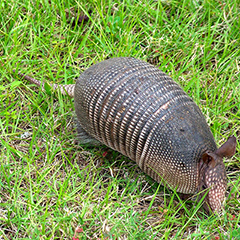
|
|
Nine-banded armadillo (Dasypus
novemcinctus) - you'll sometimes find these critters scurrying around, mostly at night.
They've been known to dig around in gardens looking for worms and
insects. |
| |

|
|
Marsh rabbit (Sylvilagus
palustris) - darker with smaller ears than their cottontail cousins. Not nearly as ubiquitous and
no cottony tail. They are
also more shy, preferring damper areas and hedges. |
| |
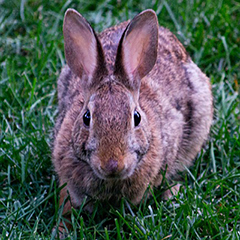
|
|
Eastern cottontail (Sylvilagus
floridanus) - so common in Gateway, they are basically lawn decor. Very
cute, but not quite as cute when they're eating your hibiscus. |
| |
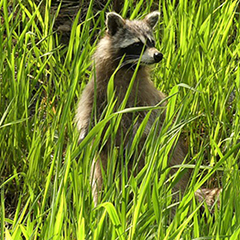
|
|
Raccoon (Procyon lotor) - Like
the rest of America, Gateway has these too. |
| |
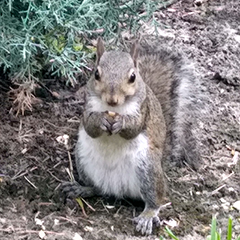
|
|
Eastern gray squirrel (Sciurus
carolinensis) - if you grew up on the east coast, these little critters
need no introduction. Wherever you're from, you will get to know them well if
you move to Gateway. |
| |
| BIRDS |
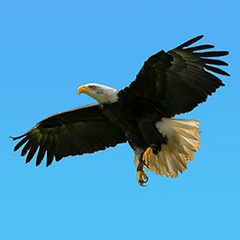
|
|
American bald eagle (Haliaeetus leucocephalus)
- America's amazing national bird flies in for an appearance now and then.
Perhaps
souring above admiring golfers or landing on some awe-struck resident's
lawn. |
| |
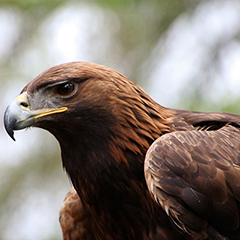
|
|
Golden Eagle (Aquila chrysaetos)
- big and beautiful. Some call them "mexican eagles." Very rare as it is
mostly a western bird, but this is the magical land of Gateway and there
have been documented sightings. |
| |

|
|
Great horned owl (Bubo virginianus)
- Magnificent and highly efficient night predator. The females, which are much larger than
the males, will at times sit on top of some lucky resident's roof and
scream loudly for a mate... in the dead of night. If this happens
anywhere in near your location you'll know it. |
| |
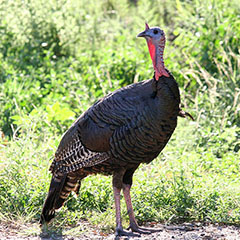
|
|
North American turkey (Meleagris gallopavo)
- not common, but seen every so often on the golf course or along wood
lines. It goes without saying we can't take game in Gateway - the HOA
would not be amused. |
| |

|
|
Western osprey (Pandion haliaetus)
- these awesome aerial predators like to fish from our many bodies of
water. |
| |

|
|
Sandhill crane (Antigone canadensis)
- Large, beautiful birds that enjoy to grazing and rearing their young in
the area fields and power lines. They'll become friends if they
like you. |
| |
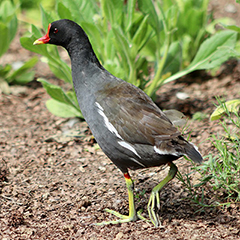
|
|
Moorhen/common gallinule (Gallinula galeata)
- known by some as "water-chickens," moorhens decorate the edges of
Gateway's lakes and waterways. |
| |

|
|
Belted kingfisher (Megaceryle alcyon)
- Kingfishers are diving birds that stand like sentries from a waterside perch,
then suddenly
kamikaze-dive for their prey. Not often found this far out from the glades, but
lots of fun
to watch when they're around. |
| |
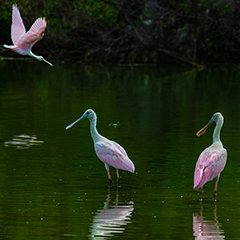
|
|
Roseate spoonbill (Platalea ajaja) - the pinkish hue
comes from their diet and is why they're sometimes mistaken for
flamingos - which Floridians see way more often on TV than in real life. Another
bird that prefers glades-like habitat, but will come for a visit. |
| |
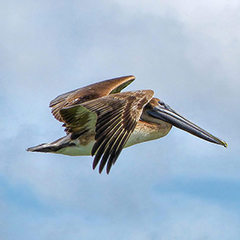
|
|
Brown pelican (Pelecanus occidentalis)
- these large fish-mongers stick mostly to the shoreline, but fly out to Gateway once in a while
to sample some of our fresh water fish. |
| |
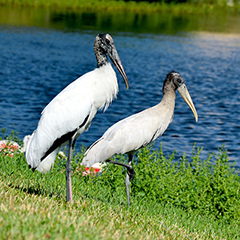
|
|
Wood stork (Mycteria americana)
- somewhat rare and welcome waders that mostly stick to the marshes, but
occasionally fish our numerous lakes, ponds and canals. |
| |
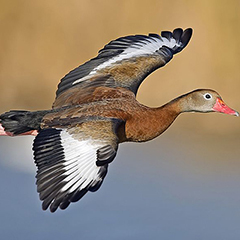
|
|
Black-bellied whistling duck (Dendrocygna
autumnalis) - Whistlers distinctive calls are frequently heard as flocks pass overhead. They
seems to like our driving-range, as large flocks have been known to
congregate there. |
| |
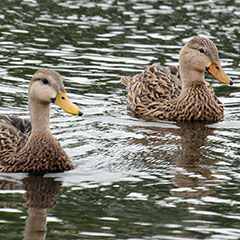
|
|
Florida mottled duck (Anas fulvigula)
- these native Floridians are most often seen together in mating pairs.
Not to be confused with mallards, these males look more like their
female mates, lacking the mallard's distinctive colors. |
| |
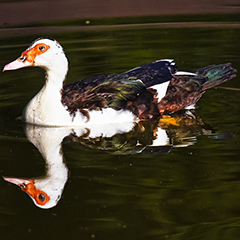
|
|
Muscovy duck (Cairina moschata)
- exotic species that is quite common throughout Florida. |
| |
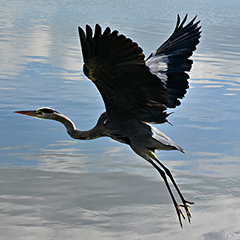
|
|
Great blue heron (Ardea herodias)
- large, beautiful waders. Shy as adults but still seen quite often
spearing meals or lofting through the air like modern pterodactyls. |
| |
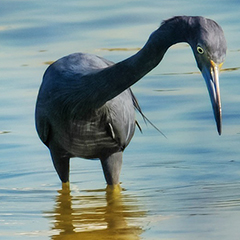
|
|
Little blue heron (Egretta caerulea) - not to be
confused with its larger and more esteemed
cousin. Different species but closely related. |
| |

|
|
Great egret (Ardea alba) - All white bird in the heron
family. Some males will get quite large as they age and develop
beautiful exotic plumage, once sought after by European hate makers. |
| |
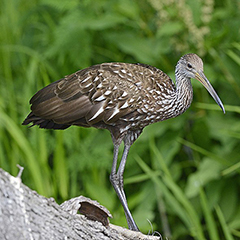
|
|
Limpkin (Aramus guarauna) - Limpkins are regularly seen
busily seeking fish around the edges of lakes and
ponds. |
| |

|
|
American white ibis (Eudocimus albus)
- Ibises like to graze along Gateway lawns and fairways in military like
formations. They'll also use their long beaks for catching small fish
and crustaceans. |
| |
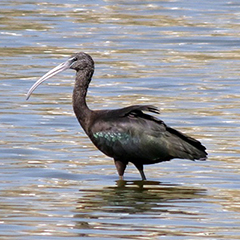
|
|
Glossy ibis (Plegadis falcinellus)
- Sometimes called a black ibis. Very similar to his white cousin. So
much so that they're often seen together, though the glossy ibis is far
less common. |
| |
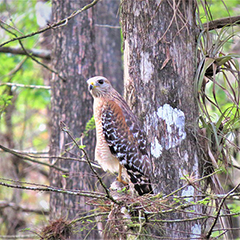
|
|
Red-shouldered hawk (Buteo lineatus)
- the most common hawk found in this part of Florida. Proficient hunters
that dine on lizards, rodents, fish and even snakes and turtles. |
| |

|
|
Merlin (Falco columbarius) -
small and fast falcon. Very agile flyers. You'll hear them chittering as
they zip around the lakes and fields. |
| |
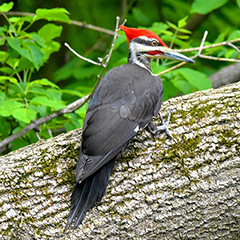
|
|
Pileated woodpecker (Dryocopus pileatus)
- the bird that inspired Woody. One of the larger and louder woodpeckers
(we have several) with a very distinctive call. |
| |

|
|
Turkey buzzard (Cathartes aura)
- part of our environmental clean-up crew. Very common in southwest
Florida. |
| |
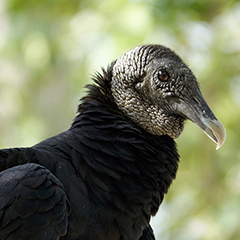
|
|
Black vulture (Coragyps atratus)
- common but not quite as common as the turkey vulture. |
| |
| REPTILES |
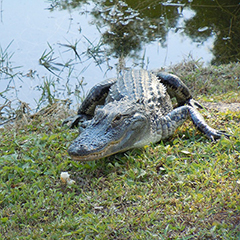
|
|
American alligator (Alligator mississippiensis)
- this once-endangered species can now be found in nearly every body of
water in Florida, Some of our larger, older and more well-known gators
even have names. DO NOT FEED. Doing so or causing them to get
comfortable around humans is not good, and could even be a death
sentence to them... or something they see as food. |
| |

|
|
Florida soft-shelled turtle (Apalone ferox)
- unique and beautiful water turtles native to Florida. Very shy unless
they know you. |
| |

|
|
Yellow-bellied slider (Trachemys scripta)
- the most common of the inland water turtles. You'll see them sunning
themselves on rocks and shorelines. Sliders will occasionally go mobile
looking for new waterways or mates. We often help them across roads so
they don't hold up traffic or get run over. |
| |
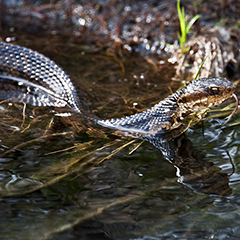
|
|
Water moccasin (Agkistrodon piscivorus) - not a common
nor welcome site, but moccasins are seen here occasionally. You don't
want to to get bit, but fortunately - contrary to lore - they're rarely deadly to humans. |
| |
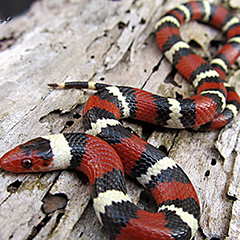
|
|
Scarlet king snake (Lampropeltis elapsoides)
- as harmless as it is useful for keeping rodents and pests away. Not to
be confused with the venomous coral snake - which has its red bands on
yellow, not black. |
| |
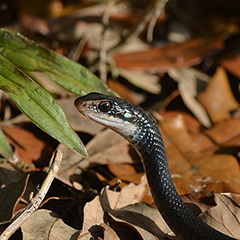
|
|
Black racer (Coluber constrictor) - sometimes
called an "eastern" racer, but these are more specific to our habitat and
darker in color. Fast moving and scary
looking to some, but harmless if left alone and very good at keeping
pests away. |
| |
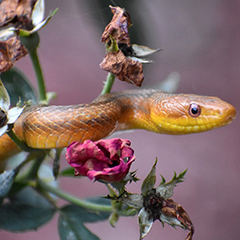
|
|
Eastern rat snake (Pantherophis alleghaniensis)
- harmless, even gentle pest-sentry. You want these in your garden. |
| |

|
|
Green anole (Anolis carolinensis)
- These will change color chameleon-like depending on their
surroundings. Unlike the brown anole, the green species is native to this area. In fact, they
were the only type of anole found in Florida before large populations
were displaced by its invasive cousin, the brown anole. |
| |
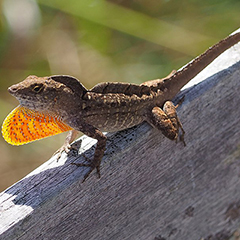
|
|
Brown anole (Anolis sagrei) -
Invasive close relative of the green anole. These originated
in Cuba and can now be found in nearly every backyard in south Florida. |
| |




